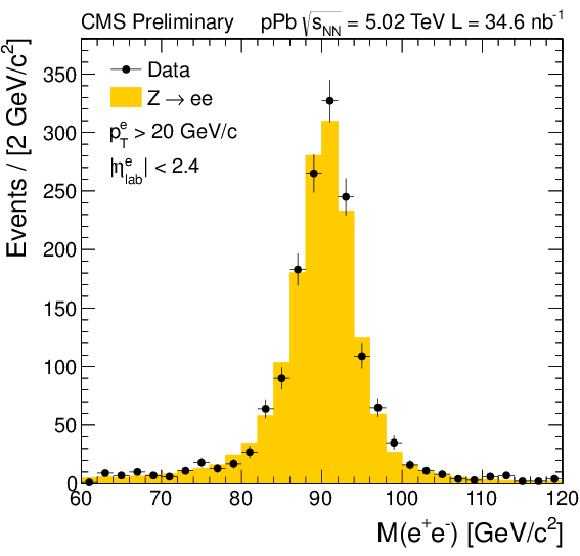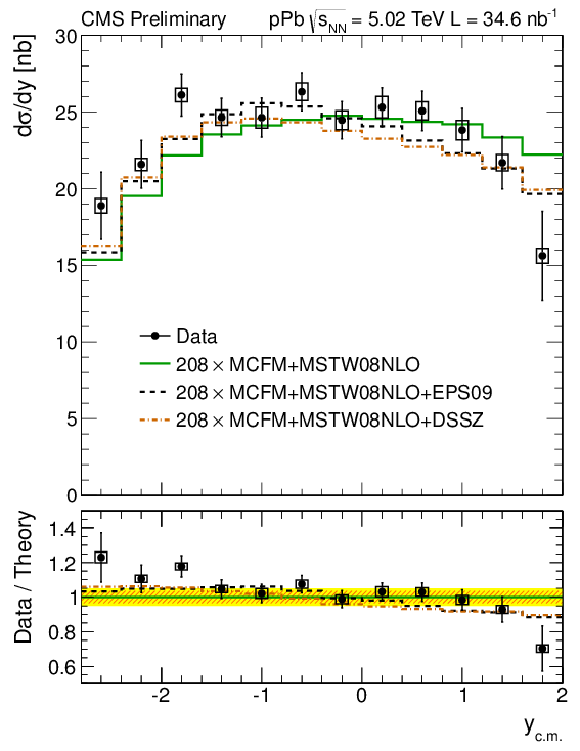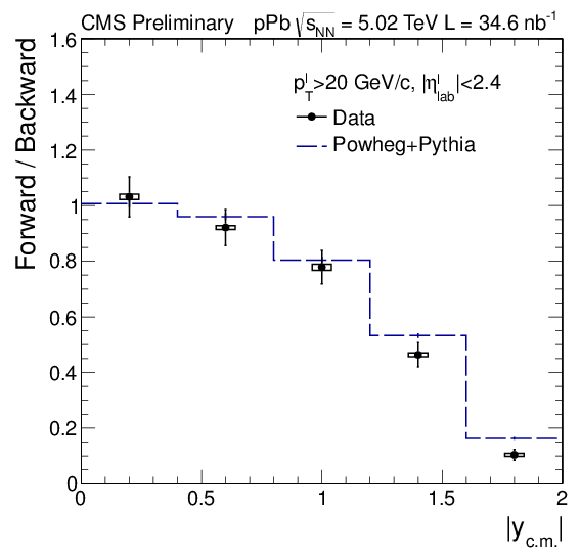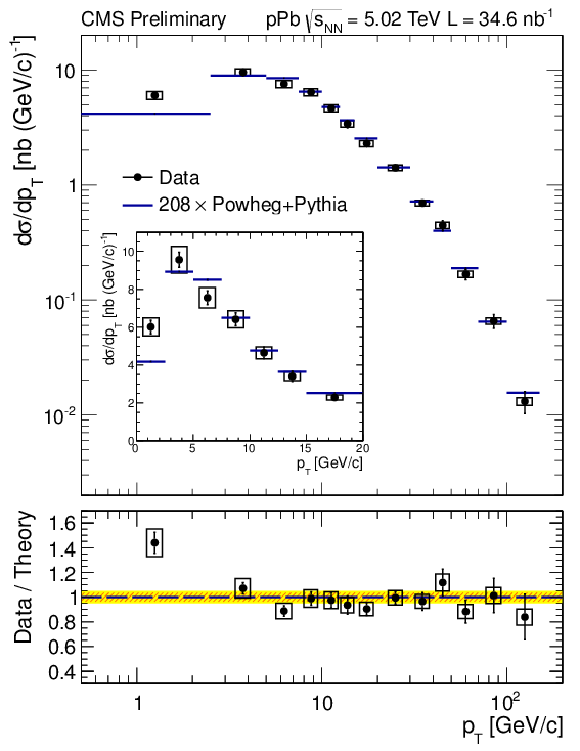

Compact Muon Solenoid
LHC, CERN
| CMS-PAS-HIN-15-002 | ||
| Study of Z boson production in the muon decay channel in pPb collisions at √sNN= 5.02 TeV | ||
| CMS Collaboration | ||
| July 2015 | ||
| Abstract: The electroweak boson production is an important benchmark measurement in ultrarelativistic heavy-ion collisions which can provide constraints on the nuclear modification of parton distribution functions. In this paper the results from the proton-lead collision data taken in early 2013 are presented. The Z boson production is studied in the electron and muon decay channels. The cross section is measured in bins of the Z boson rapidity and transverse momentum and compared to theoretical predictions. The Z boson production is observed to be proportional to the number of elementary nucleon-nucleon collisions within the uncertainties. The forward-backward ratio of the measured cross section is presented. | ||
|
Links:
CDS record (PDF) ;
Public twiki page ;
CADI line (restricted) ; Figures are also available from the CDS record. These preliminary results are superseded in this paper, PLB 759 (2016) 36. |
||
| Figures | |

png ; pdf |
Figure 1-a:
Invariant mass of selected muon (a) and electron (b) pairs from pPb data compared to PYTHIA 6 + HIJING simulated pN→Z→ℓℓ events with N=p, n according to the number of nucleons in the Pb nucleus. The MC sample is normalized to the number of events in the data. |

png ; pdf |
Figure 1-b:
Invariant mass of selected muon (a) and electron (b) pairs from pPb data compared to PYTHIA 6 + HIJING simulated pN→Z→ℓℓ events with N=p, n according to the number of nucleons in the Pb nucleus. The MC sample is normalized to the number of events in the data. |

png ; pdf |
Figure 2-a:
Differential cross section of Z bosons in pPb collisions as a function of rapidity in the fiducial region (a) and corrected to full acceptance (b) for the combined leptonic decay channel compared to predictions from POWHEG + PYTHIA 6 and MCFM generators scaled by the number of nucleons in the Pb nucleus. The 3.5% luminosity uncertainty is shown in the ratio plot as a hashed band together with the assumed 5% theoretical uncertainty shown as a yellow band. |

png ; pdf |
Figure 2-b:
Differential cross section of Z bosons in pPb collisions as a function of rapidity in the fiducial region (a) and corrected to full acceptance (b) for the combined leptonic decay channel compared to predictions from POWHEG + PYTHIA 6 and MCFM generators scaled by the number of nucleons in the Pb nucleus. The 3.5% luminosity uncertainty is shown in the ratio plot as a hashed band together with the assumed 5% theoretical uncertainty shown as a yellow band. |

png ; pdf |
Figure 3-a:
Forward-backward asymmetry distributions of Z bosons in pPb collisions as a function of rapidity in the fiducial region (a) and corrected to full acceptance (b) for the combined leptonic decay channel compared to predictions from POWHEG + PYTHIA 6 and MCFM generators. |

png ; pdf |
Figure 3-b:
Forward-backward asymmetry distributions of Z bosons in pPb collisions as a function of rapidity in the fiducial region (a) and corrected to full acceptance (b) for the combined leptonic decay channel compared to predictions from POWHEG + PYTHIA 6 and MCFM generators. |

png ; pdf |
Figure 4-a:
Differential cross section of Z bosons in pPb collisions as a function of transverse momentum in the fiducial region (a) and corrected to full acceptance (b) for the combined leptonic decay channel compared to predictions from POWHEG + PYTHIA 6 generator scaled by the number of nucleons in the Pb nucleus. The 3.5% luminosity uncertainty is shown in the ratio plot as a hashed band together with the assumed 5% theoretical uncertainty shown as a yellow band. |

png ; pdf |
Figure 4-b:
Differential cross section of Z bosons in pPb collisions as a function of transverse momentum in the fiducial region (a) and corrected to full acceptance (b) for the combined leptonic decay channel compared to predictions from POWHEG + PYTHIA 6 generator scaled by the number of nucleons in the Pb nucleus. The 3.5% luminosity uncertainty is shown in the ratio plot as a hashed band together with the assumed 5% theoretical uncertainty shown as a yellow band. |

|
Compact Muon Solenoid LHC, CERN |

|

|

|

|

|

|